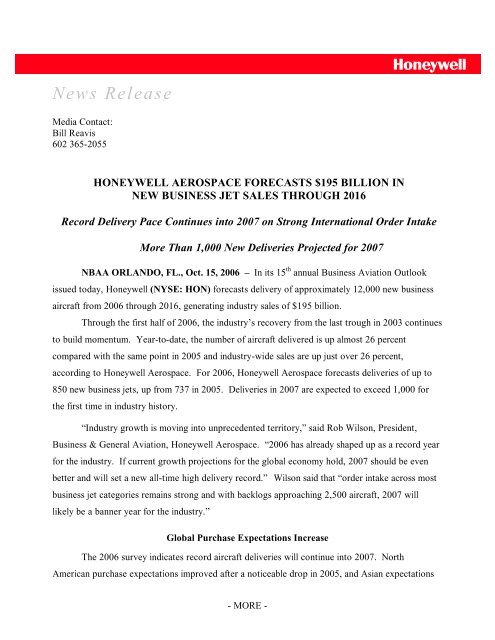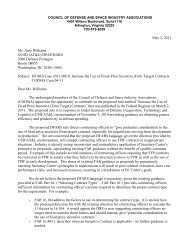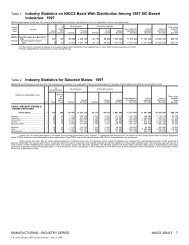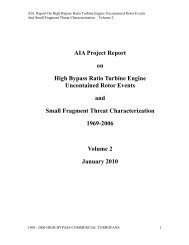Honeywell Forecast 2007 to 2016 - Aerospace Industries Association
Honeywell Forecast 2007 to 2016 - Aerospace Industries Association
Honeywell Forecast 2007 to 2016 - Aerospace Industries Association
Create successful ePaper yourself
Turn your PDF publications into a flip-book with our unique Google optimized e-Paper software.
4 06 Business Aviation <strong>Forecast</strong>weaker buying plans reported in last year’s survey. The stronger used jet purchase plans recordedthis year should begin <strong>to</strong> be felt over the next 12 months. An encouraging note is that used jetreplacement and expansion plans are up in the core North American region as well as in Europeover 2005 levels.“There is no doubt world economic conditions underpin a large part of business jetexpansion, but the industry is also realizing the benefits of steady gains in aircraft value <strong>to</strong> theopera<strong>to</strong>r and passenger in the form of improved aircraft reliability, mission flexibility, cabinproductivity, comfort and convenience,” Wilson said. “His<strong>to</strong>rically, <strong>Honeywell</strong> <strong>Aerospace</strong>’sBusiness Aviation Outlook shows increases in purchase plans and subsequent aircraft deliveriestend <strong>to</strong> be highly associated with the introduction of new aircraft. Business Aviation will never beinsulated from economic cycles, but it’s clear that manufacturers help stimulate demand with newmodels incorporating advances in aviation technology,” he said. “Improved engines, safetysystems, cockpit avionics and cabin information and comfort improvements along with advances inaerodynamic design can deliver compelling gains in value <strong>to</strong> fleet opera<strong>to</strong>rs, pilots and passengers.”Global Economy and New Product Pipeline Favor Long-Term GrowthMost of the economic fac<strong>to</strong>rs that support demand for business jets favor continued industrygrowth. Projections regarding growth in U.S. gross domestic product call for a slow-down over thenext six <strong>to</strong> seven quarters, but stronger growth subsequently resumes. Regional economic growthrates are all generally favorable for the industry, especially within Central Europe, Asia, the MiddleEast and Sub-Saharan Africa. In addition, <strong>Honeywell</strong> <strong>Aerospace</strong>’s “Cus<strong>to</strong>mer Benefit Index,” a keycomponent of the forecast, which tracks the perceived value offered by business jets <strong>to</strong> fleet ownersand opera<strong>to</strong>rs, continues <strong>to</strong> trend upward. “When coupled with the improved purchase plans fromthe opera<strong>to</strong>r survey, a broad alignment of positive influences for the industry is in place,” Wilsonadded.Owners of fleets serving fractional shareholders and Jet Card purchasers continue <strong>to</strong> providea substantial portion of <strong>to</strong>tal industry demand. Fractional fleet opera<strong>to</strong>rs still account for about 30percent of the backlog for business jets. New deliveries <strong>to</strong> fractional fleet opera<strong>to</strong>rs should rangebetween 85 and more than 120 aircraft annually through the forecast period. While sales of newownership shares have flattened significantly since 2004, sales of jet cards – which offer businessjet access in smaller blocks of flight hours without a long-term financial commitment or equity
6 06 Business Aviation <strong>Forecast</strong>North America is expected <strong>to</strong> account for about 61 percent of business jet deliveries over thenext five years, still a lower-than-typical share of global demand reflecting high levels of recentsales in the region and the high levels of purchase expectations in all other areas.Asia is up strongly and is expected <strong>to</strong> account for up <strong>to</strong> 13 percent of <strong>to</strong>tal business jetdemand in the next five years, in a virtual tie with Europe. Latin America follows at 10 percent andThe Middle East/Africa region remains steady over last year at four percent. Europe remains flat at12 percent. Keep in mind that while these percentages have shifted somewhat the overall demandpool has grown so individual regions are still absorbing significant numbers of new aircraft in<strong>to</strong>their fleets, even if percentage share slips a few points.Demand Trends by Aircraft SegmentThe 2006 Business Aviation Outlook provides the following estimates of demand trends byaircraft class:Long-Range and Ultra Long-Range: Deliveries of aircraft in these segments are projected<strong>to</strong> <strong>to</strong>p 1,600 in the forecast period. Deliveries may range as high as 170 aircraft and should average140 <strong>to</strong> 160 per year over the entire forecast. Aircraft in this category include the BombardierGlobal Express and Global 5000, Challenger 850, Gulfstream 450, 500 and 550, Falcon 900EX,Falcon 900D and the new Falcon F7X.Large: <strong>Honeywell</strong> <strong>Aerospace</strong> forecasts delivery of more than 1,300 large business jets overthe forecast period. Near-term, deliveries are expected <strong>to</strong> peak in 2006 or <strong>2007</strong> at more than 100aircraft, then decline slightly <strong>to</strong> a stable level of around 95 aircraft per year until trending up againin 2012 and beyond. Aircraft in this category include the Challenger 604/605, Gulfstream 350,Falcon 2000, Falcon 2000EX and Embraer Legacy 600.Medium and Medium-Large: Combined, new aircraft deliveries in these segments areforecast <strong>to</strong> approach 250 annually in 2006 with deliveries rising further <strong>to</strong> average around 300 unitsannually through <strong>2016</strong>. Deliveries for the forecast period should <strong>to</strong>tal more than 3,300 aircraft. Jetsin these segments continue <strong>to</strong> enjoy strong interest from fractional fleet opera<strong>to</strong>rs. Growth in thesesegments is also being fueled by the introduction of new models, both near-term and in the lateryears of the forecast period. Among the newer aircraft in these segments are the CitationSovereign, Gulfstream G150, Hawker 850XP and Hawker 4000. Established platforms include theBombardier Challenger 300, Citation X, Gulfstream G200, Falcon 50EX, and Learjet 60.
7 06 Business Aviation <strong>Forecast</strong>Light and Light-Medium: <strong>Honeywell</strong> <strong>Aerospace</strong> anticipates deliveries of more than 3,250jets in these segments between 2006 and <strong>2016</strong>, an increase of more than 12 percent compared withdelivery expectations for these segments in last year’s Business Aviation Outlook. As previouslynoted, the light and light-medium segments continue <strong>to</strong> be one of the largest categories of surveyrespondents’ expected jet purchases in the 2006 survey. Aircraft in these segments include theHawker 400XP, Citation Bravo, Citation Encore+, CJ3 (525B), Citation XLS, Grob SP n , EmbraerPhenom 300, Lear 40 and Lear 45/45XR.Very Light: Deliveries of business jets in this segment are poised <strong>to</strong> accelerate rapidly off abase of around 100 units in 2006. Deliveries are forecast <strong>to</strong> increase dramatically in <strong>2007</strong> andbeyond, averaging just under 250 aircraft per year for the duration of the forecast period. The rapidincrease in projected demand reflects the introduction of new very light jets, such as the EmbraerPhenom 100 and Cessna Citation Mustang, both of which already enjoy strong order backlogs.Also entering the segment is the recently announced HondaJet. Total deliveries of very light jets forthe 2006 <strong>to</strong> <strong>2016</strong> period are expected <strong>to</strong> exceed 2,500. Other production and announced aircraft inthis segment include the Cessna CJ1+ and CJ2+, Beechcraft Premier I and Sino-Swearingen SJ30-2.Personal Jets: The 2006 Business Aviation Outlook builds on last year’s initial surveyfindings by providing an updated look at the emerging General Aviation Jet segment. This portionof industry demand has centered on the emergence of very light aircraft such as the Eclipse 500,Adam 700, Diamond Jet, Cirrus and others not normally covered by the Business Aviation Outlook.<strong>Honeywell</strong> <strong>Aerospace</strong> projections are based on general aviation or owner-pilot survey datacollected last year and corporate flight department interest reflected in the 2006 purchaseexpectations survey. Total demand potential over a 10-year period is estimated <strong>to</strong> be in the range of4,000 very light personal jets. When combined with new-generation low-cost aircraft carried in theVery Light segment of the Business Aviation Outlook, the <strong>to</strong>tal deliveries exceed 5,000 aircraf<strong>to</strong>ver the next 10 years and fall directly in the range predicted by the 2005 survey. The projectionsexclude demand from fractional ownership companies or from emerging “air taxi” opera<strong>to</strong>rs thatmay rely on ultra-light jets as the core of their fleets. These additional sources of demand could addsignificantly <strong>to</strong> the baseline owner-opera<strong>to</strong>r demand.Business Liners: The current Business Aviation Outlook does not explicitly include aircraftin the Business Liner class (typically well over 100,000 pounds takeoff weight and based ontransport airframes). However, purchase expectations are recorded for these models in the survey.
8 06 Business Aviation <strong>Forecast</strong>Deliveries of aircraft in this class are projected <strong>to</strong> <strong>to</strong>tal around 200 through <strong>2016</strong> and should averagemore than 20 aircraft per year in the latter part of the forecast period. Aircraft represented in thissegment include the Boeing BBJ series, the Airbus Elite A318 and Airbus Corporate Jetliner as wellas the Lineage 1000 from Embraer. This segment comprises an additional $11 <strong>to</strong> 12 billion ofbusiness aircraft sales.The <strong>Honeywell</strong> <strong>Aerospace</strong> Business Aviation Outlook and the purchase expectations itsummarizes are a snapshot of expected business aircraft sales at a point in time and reflect flee<strong>to</strong>pera<strong>to</strong>rs’ views of current events, such as political and economic conditions, fuel costs andchanges in regulations, taxes and user fees that would affect expected sales in the near term.<strong>Honeywell</strong> <strong>Aerospace</strong>’s Business Aviation Outlook does not reflect the impact of unforeseen eventssuch as a war, major economic shock, fuel crisis or new regula<strong>to</strong>ry restrictions. The Outlook isbased in part on Global Insight’s baseline economic forecast assumptions that call for economicgrowth at quarterly rates in the two-<strong>to</strong>-three percent range for the next six quarters, and exceedingthree percent thereafter.<strong>Honeywell</strong> <strong>Aerospace</strong> has produced its Business Aviation Outlook for 20 years and hasshared the findings publicly for the last 15 years. This year’s Business Aviation Outlook is derivedfrom interviews with 1,400 corporate flight departments around the world that operate more than 10percent of the world’s turbine-powered fixed-wing aircraft. The Outlook is also shaped byinformation from aircraft manufacturers, other industry sources and <strong>Honeywell</strong> <strong>Aerospace</strong>’sanalysis of the impact of various economic indica<strong>to</strong>rs on industry demand trends. <strong>Honeywell</strong>’sBusiness Aviation Outlook tracks purchase expectations for business jets with gross take-off weight(GTOW) of less than 100,000 pounds.<strong>Honeywell</strong> International is a $30 billion diversified technology and manufacturing leader, serving cus<strong>to</strong>mersworldwide with aerospace products and services; control technologies for buildings, homes and industry; au<strong>to</strong>motiveproducts; turbochargers; and specialty materials. Based in Morris Township, N.J., <strong>Honeywell</strong>’s shares are traded on theNew York, London, Chicago and Pacific S<strong>to</strong>ck Exchanges. It is one of the 30 s<strong>to</strong>cks that make up the Dow JonesIndustrial Average and is also a component of the Standard & Poor's 500 Index. For additional information, please visitwww.honeywell.comBased in Phoenix, <strong>Honeywell</strong>’s aerospace business is a leading global provider of integrated avionics, engines,systems and service solutions for aircraft manufacturers, airlines, business and general aviation, military, space andairport operations.This release contains forward-looking statements as defined in Section 21E of the Securities Exchange Act of 1934,including statements about future business operations, financial performance and market conditions. Such forwardlookingstatements involve risks and uncertainties inherent in business forecasts as further described in our filings underthe Securities Exchange Act.
















